Journal of Hazardous Materials ( IF 12.2 ) Pub Date : 2022-06-21 , DOI: 10.1016/j.jhazmat.2022.129433 YanMing Zhu 1 , ZengFei Li 1 , Jun Shen 1 , KongYuan Wu 1 , PingPing Zhao 1 , ZiHan Wu 1 , ZiQing Liu 1 , JiGang Yang 1 , Hong Liu 1 , Christopher Rensing 1 , RenWei Feng 1

|
Antimony (Sb) is a toxic metalloid, and excess Sb causes damage to the plant photosynthetic system. However, the underlying mechanisms of Sb toxicity in the plant photosynthetic system are not clear. Hydroponic culture experiments were conducted to illustrate the toxicity differences of antimonite [Sb(III)] and antimonate [Sb(V)] to the photosynthetic system in a rice plant (Yangdao No. 6). The results showed that Sb(III) showed a higher toxicity than Sb(V), judging from 1) lower shoot and root biomass, leaf water moisture content, water use efficiency, stomatal conductance, net photosynthetic rate, and transpiration rate; 2) higher water vapor deficit, soluble sugar content, starch content, and oligosaccharide content (sucrose, stachyose, and 1–kestose). To further analyze the direction of the photosynthetic products, we conducted a metabonomic analysis. More glycosyls were allocated to the synthesis pathways of oligosaccharides (sucrose, stachyose, and 1–kestose), anthocyanins, salicylic acid, flavones, flavonols, and lignin under Sb stress to quench excess oxygen free radicals (ROS), strengthen the cell wall structure, rebalance the cell membrane, and/or regulate cell permeability. This study provides a complete mechanism to elucidate the toxicity differences of Sb(III) and Sb(V) by exploring their effects on photosynthesis, saccharide synthesis, and the subsequent flow directions of glycosyls.
中文翻译:

不同形式锑对水稻植物的毒性:光合电子转移、气体交换、光合效率和碳同化结合代谢组分析
锑 (Sb) 是一种有毒的准金属,过量的 Sb 会对植物的光合系统造成损害。然而,植物光合系统中 Sb 毒性的潜在机制尚不清楚。进行了水培试验,以说明锑酸盐[Sb(III)]和锑酸盐[Sb(V)]对水稻(阳稻6号)光合系统的毒性差异。结果表明,Sb(III)的毒性高于Sb(V),从1)较低的茎和根生物量、叶片水分含量、水分利用效率、气孔导度、净光合速率和蒸腾速率来看;2) 较高的水蒸气不足、可溶性糖含量、淀粉含量和低聚糖含量(蔗糖、水苏糖和 1-酮糖)。为了进一步分析光合产物的方向,我们进行了代谢组学分析。在 Sb 胁迫下,更多的糖基被分配到寡糖(蔗糖、水苏糖和 1-酮糖)、花青素、水杨酸、黄酮、黄酮醇和木质素的合成途径中,以淬灭过量的氧自由基 (ROS),增强细胞壁结构,重新平衡细胞膜,和/或调节细胞通透性。本研究通过探索 Sb(III) 和 Sb(V) 对光合作用、糖类合成和随后糖基流动方向的影响,为阐明 Sb(III) 和 Sb(V) 的毒性差异提供了一个完整的机制。加强细胞壁结构,重新平衡细胞膜,和/或调节细胞通透性。本研究通过探索 Sb(III) 和 Sb(V) 对光合作用、糖类合成和随后糖基流动方向的影响,为阐明 Sb(III) 和 Sb(V) 的毒性差异提供了一个完整的机制。加强细胞壁结构,重新平衡细胞膜,和/或调节细胞通透性。本研究通过探索 Sb(III) 和 Sb(V) 对光合作用、糖类合成和随后糖基流动方向的影响,为阐明 Sb(III) 和 Sb(V) 的毒性差异提供了一个完整的机制。











































 京公网安备 11010802027423号
京公网安备 11010802027423号